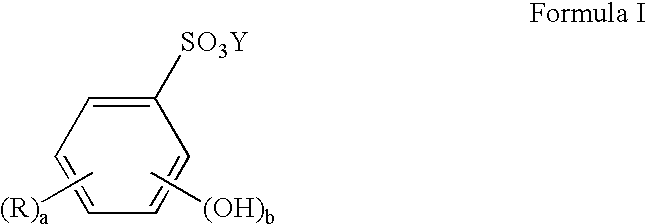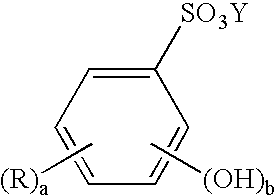Limiting the loss of tin through oxidation in tin or tin alloy electroplating bath solutions
a technology of tin alloy and electroplating bath solution, which is applied in the direction of liquid/solution decomposition chemical coating, solid/suspension decomposition chemical coating, coating, etc., can solve the problems of increased operational costs, inferior products, and loss of available divalent tin (snsup>2+/sup>), and achieve the effect of reducing the oxidation divalent tin
- Summary
- Abstract
- Description
- Claims
- Application Information
AI Technical Summary
Benefits of technology
Problems solved by technology
Method used
Image
Examples
examples
[0024]Tests were conducted to evaluate the formation of insoluble materials, and to evaluate the effectiveness of antioxidants to prevent the loss of divalent tin in the plating baths. Combinations of antioxidants were also evaluated.
[0025]Accelerated testing was conducted to determine the effect various antioxidants have on the formation of insoluble oils and / or gels. During the test, one liter of test solution was maintained at between 30 and 50° C. under stir bar agitation. Stainless steel electrodes were placed under a load of 10 amps. Ethoxylated (EO) and propoxylated (PO) surfactants were combined in water with methane sulfonic acid (MSA), and the antioxidant under evaluation. “EO / PO-butanol” refers to a copolymer of ethylene oxide and propylene oxide having one end terminated with butanol. “EO-bis-phenol” refers to an ethylene oxide polymer having both ends terminated with phenol. The results are in Table 1.
[0026]
TABLE 1Conc.Conc.Conc.Example No.Acidg / lSurfactantg / lAntioxidan...
PUM
| Property | Measurement | Unit |
|---|---|---|
| cloud point | aaaaa | aaaaa |
| concentration | aaaaa | aaaaa |
| concentration | aaaaa | aaaaa |
Abstract
Description
Claims
Application Information
 Login to View More
Login to View More - R&D
- Intellectual Property
- Life Sciences
- Materials
- Tech Scout
- Unparalleled Data Quality
- Higher Quality Content
- 60% Fewer Hallucinations
Browse by: Latest US Patents, China's latest patents, Technical Efficacy Thesaurus, Application Domain, Technology Topic, Popular Technical Reports.
© 2025 PatSnap. All rights reserved.Legal|Privacy policy|Modern Slavery Act Transparency Statement|Sitemap|About US| Contact US: help@patsnap.com



